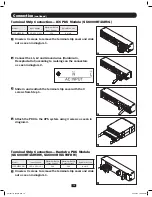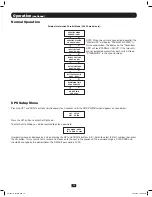
9
Connection
1
Plug your UPS’s input cord into an electrical outlet.
(SU5000RT4UHV, SU5000RT4UTF, SU6000RT4UHV,
SU6000RT4UTF)
Your UPS must be connected to a dedicated circuit of sufficient amperage.
Note! After you connect the UPS to a live AC power source, the UPS LCD will
display “BYPASS MODE” and will automatically charge its batteries while providing
power to the output.
If you have a PDU with manual bypass, set the PDU bypass switch to “NORMAL.”
2
Turn UPS ON.
Press the UPS’s “ON” Button until you hear a beep to begin inverter operation.
Your UPS will perform a brief self-test and show the results on the LCD Display.
See “Startup Self-Test” in the “Operation” section for the display sequence. Your
UPS will now provide filtered power to the AC output.
Note: UPS system will function properly upon initial startup; however, maximum
runtime for the unit’s battery will only be accessible after it has been charged for 24 hours.
3
Plug your equipment into your UPS.
Your UPS is designed to support electronic equipment only. You will overload your
UPS if the total VA rating for all the equipment you connect exceeds the UPS’s
output capacity. Do not connect household appliances or laser printers to the
UPS’s outlets. To find your equipment’s VA ratings, look on their nameplates. If
the equipment is listed in amps, multiply the number of amps by the input
voltage(200V~240V ) to determine VA. (Example : 1 amp x 208V = 208VA).
4
Turn UPS OFF (Optional).
Press the UPS’s “OFF” button until you hear a beep. You will be presented with a Yes/No option. Select Yes to continue to turn
off the UPS. Select No to cancel. The UPS will continue to automatically charge its batteries and provide unfiltered (BYPASSED)
AC output as long as AC input power is present. To completely deactivate the UPS, unplug the UPS’s input cord when the UPS
system is in standby mode.
5
UPS Cold Start (Optional).
To use your UPS as a stand-alone power source when AC input power is unavailable (i.e. during a blackout), you can “cold
start” your UPS and power connected equipment from the UPS’s battery. Your UPS’s battery must be at least partially charged
for this operation to succeed. Press and hold the “ON” button until you hear a beep to cold start your UPS. The LCD Display
will show ON BATTERY MODE. Battery power will begin discharging. Some electronic equipment may draw more amps during
startup; when cold starting, consider reducing the initial load on the UPS.
Note: The output voltage is set at 208~(default) by the manufacturer. If you need to change the output voltage of the
UPS, refer to “Output Voltage Selection” in the “Operation” section. You should select the correct output voltage before
connecting your equipment to the UPS.
Terminal Strip Input Connections
(SU6000RT4UHVHW, SU6000RT4UHVG, SU6000RT4UTFHW)
Note: For SU12KRT4UHW Hardwiring information, see the manual included with the Parallel PDU.
Hardwiring Cautions
• Wiring must be done by a qualified electrician.
• When making wiring connections, observe the cable connection regulations appropriate to your area [e.g. National Electrical
Code (NEC) in the U.S.] at all times. Be sure to install an easily accessible disconnect switch in your installation wiring so you
may cut off the UPS’s AC input during fires and other emergencies. Ensure that cables are fitted with cable sleeves and are
secured by connector clamps. Tighten connections with a torque of not less than 24-28 inch-pounds (2.7-3.2 NM).
• Make sure that your equipment is properly grounded.
• Using cables of improper size may damage your equipment and cause fire hazards. Choose appropriate cabling and protection
circuits to make wiring connections. Ground conductors must be the same size and type as the power conductors used.
• Refer to National Electrical Code (NEC) guidelines for proper wire gauge and output protection circuit requirements.
1
2
3
201207113 933070.indb 9
9/17/2012 1:19:57 PM
























